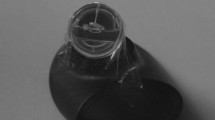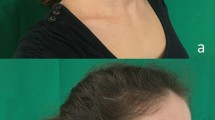Abstract
The objective of this study was to investigate the thermal effects of cold light sources and endoscopes on the inner ear. 25 male guinea pigs were assigned equally to five groups (1: Halogen—1 min, 2: Halogen—5 min, 3: Xenon—1 min, 4: Xenon—5 min, 5: Controls). After both bullae of the guinea pigs were opened, light sources and endoscopes were positioned in the middle ears of the first four groups for specific time periods. DPOAE and ABR tests were conducted on all animals at the beginning of the study, at the end of surgery, and 2 h after surgery. The temperatures of cold light sources were measured by a thermocouple thermometer, and the surface temperatures of the endoscopes were measured by an infrared thermometer. DPOAE and ABR measurements performed right after and 2 h after surgery in group 1, 2, 3, and 5 did not reveal any significant difference. In group 4, DPOAE values were significantly lower and ABR threshold values were significantly higher than those in the other groups, right after and 2 h after surgery. Thermocouple thermometer readings showed that, after the first minute, the Xenon light source generated significantly more temperature rise than the Halogen light source. The surface temperatures of all endoscopes returned to normal approximately 1 min after light sources were turned off. Our study demonstrated that when an endoscope using a Xenon light source was applied to the middle ear for a specific time periods, inner ear functions deteriorated, as reflected by audiologic tests.






Similar content being viewed by others
References
Rehl RM, Oliaei S, Ziai K, Mahboubi H, Djalilian HR (2012) Tympanomastoidectomy with otoendoscopy. Ear Nose Throat J 91(12):527–532
Youssef TF, Poe DS (1997) Endoscope-assisted second-stage tympanomastoidectomy. Laryngoscope 107(10):1341–1344
Ayache S, Tramier B, Strunski V (2008) Otoendoscopy in cholesteatoma surgery of the middle ear: what benefits can be expected? Otol Neurotol 29(8):1085–1090
Liu Y, Sun JJ, Lin YS, Zhao DH, Zhao J, Lei F (2010) Otoendoscopic treatment of hidden lesions in otomastoiditis. Chin Med J 123(3):291–295
Hori T, Okada Y, Maruyama T, Chernov M, Attia W (2006) Endoscope-controlled removal of intrameatal vestibular schwannomas. Minim Invasive Neurosurg 49(1):25–29
Nelson JJ, Goyal P (2011) Temperature variations of nasal endoscopes. Laryngoscope 121(2):273–278
Yavuz Y, Skogås JG, Güllüoğlu MG, Langø T, Mårvik R (2006) Are cold light sources really cold? Surg Laparosc Endosc Percutan Tech 16(5):370–376
Bottrill I, Perrault DF Jr, Poe D (1996) In vitro and in vivo determination of the thermal effect of middle ear endoscopy. Laryngoscope 106(2):213–216
MacKeith SA, Frampton S, Pothier DD (2008) Thermal properties of operative endoscopes used in otorhinolaryngology. J Laryngol Otol 122(7):711–714
Institute of Laboratory Animal Research (1996) Commission on Life Sciences. National Research Council. The Guide for the Care and Use of Laboratory Animals, 7th edn. National Academy of Sciences, Washington DC
El-Meselaty K, Badr-El-Dine M, Mandour M, Mourad M, Darweesh R (2003) Endoscope affects decision making in cholesteatoma surgery. Otolaryngol Head Neck Surg 129:490–496
Stoll AM, Greeen LC (1959) Relationship between pain and tissue damage due to thermal radiation. J Appl Physiol 14(3):373–382
Bellina JH, Haas M (1984) Cold light sources. Are they really cold? J Reprod Med 29(4):275–277
Sandhu H, Turner R, Pozo JL (2002) No smoke without fire—simple recommendations to avoid arthroscopic burns. Knee 9(4):341–346
Tomazic PV, Hammer GP, Gerstenberger C, Koele W, Stammberger H (2012) Heat development at nasal endoscopes’ tips: danger of tissue damage? A laboratory study. Laryngoscope 122:1670–1673
Brown GJE, Saunders BP (2005) Advances in colonic imaging: technical improvements in colonoscopy. Eur J Gastroenterol Hepatol 17(8):785–792
Levine RA, Bu-Saba N, Brown MC (1993) Laser-Doppler measurements and electrocochleography during ischemia of the guinea pig cochlea: implications for hearing preservation in acoustic neuroma surgery. Ann Otol Rhinol Laryngol 102(2):127–136
Conflict of interest
The authors state that this is an original work that has not been published or submitted to another journal. We did not receive any financial support, and there is no conflict of interest
Author information
Authors and Affiliations
Corresponding author
Additional information
This study was awarded in the the first Meeting of GLORF—Global Otology Research Meeting in November 13, 2013 in Antalya, Turkey as part of 29th Politzer Society Meeting by the international jury in the section of middle ear surgery.
Rights and permissions
About this article
Cite this article
Aksoy, F., Dogan, R., Ozturan, O. et al. Thermal effects of cold light sources used in otologic surgery. Eur Arch Otorhinolaryngol 272, 2679–2687 (2015). https://doi.org/10.1007/s00405-014-3202-4
Received:
Accepted:
Published:
Issue Date:
DOI: https://doi.org/10.1007/s00405-014-3202-4




